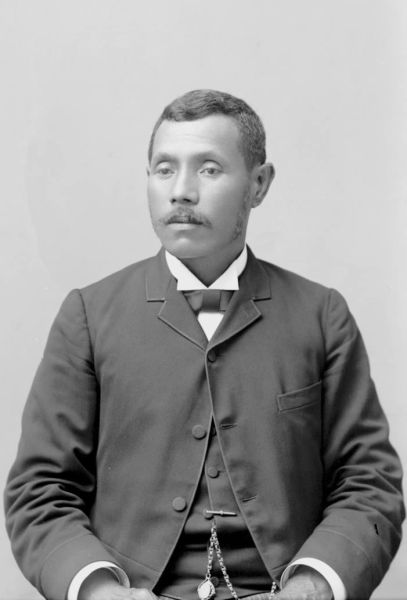Digital Collections
Celebrating the breadth and depth of Hawaiian knowledge. Amplifying Pacific voices of resiliency and hope. Recording the wisdom of past and present to help shape our future.
J. Nāwahī
This article was printed in the very first issue of the Hawaiian language newspaper Ke Aloha Aina, dated 25 May 1895 and written by the paper’s editor, Joseph Kahoʻoluhi Nāwahīokalaniʻōpuʻu. We present it here in its original orthography, with a contemporary translation below.
Ke Aloha Aina;
Heaha Ia?
O ke Aloha Aina, oia ka Ume Mageneti iloko o ka puuwai o ka Lahui, e kaohi ana i ka noho Kuokoa Lanakila ana o kona one hanau ponoi.
O ka Ume Mageneti, oia no ka ikaika nana i kaohi i ke kui magen[e]ti o ke Panana, e hoʻopololei ana i kona kuhikuhi i ka welelau Akau o ka Honua nei, a i ka hoku akau hoi.
He mea pohihihi ka ike ana i kahi i loaa ai ia mea he ume iloko o ka hao Mageneti, aka, eia ka mea maopopo loa, aia kela kui Mageneti ke hoomau la i kona kuhikuhi ana i ka hoku akau ma ka welau akau o [ka] honua nei.
Pela ke aloha iloko o ka puuwai o ke kanaka no kona aina hanau ponoi. Aole i ike maka ia ia mea he aloha, aole hoi hiki ke hoopaaia, aole hoi e hiki ke haha ia; aka, ua laha wale aku oia, a ua lele wale aku a pili i kona aina hanau ponoi iho, me he ume la o ke kui Mageneti.
Ina i hookokoke ia na kui hao Mageneti i kahi hookahi, alaila, he mea maopopo loa me ke kanalua ole o ka manao, ua ume like no lakou a pau loa kekahi i kekahi.
Pela hoi na lahui a me na kanaka a pau loa i noho pihaia e ka uhane aloha i ka aina hanau. E ike auanei ko lakou huki ana, ume ana, a me ko lakou kaohi ana i ka noho Kuokoa Lanakila ana o ko lakou aina hanau.
Na kela aloha iloko o lakou e lana, ua lilo ka hune, ka nele, ka inea a me na popilikia he nui i mea ole loa ia lakou. No ka mea, ua nui aku ke aloha no ka aina hanau mamua o na mea e ae a pau loa.
He holoholona ke kanaka ke nele oia i keia ano he Aloha Aina, a i ole ia, he kumakaia paha kona ano like loa. He haahaa loa ke kulana o ke kanaka aloha ole a kumakaia paha i kona one hanau. Aohe ona noonoo hou ia he pono ka i koe iaia, a e maalo ae ana oia iwaena o kona lahui ponoi iho me ka hoowahawaha loa ia aku e lakou.
Aloha ʻĀina;
What is it?
That which we call Aloha ‘Āina is the magnetic pull in the heart of the patriot which compels the sovereign existence of the land of his birth.
Magnetism is the power which directs the needle of a compass so that it will always point directly to the North Pole of the Earth, and therefore toward the North Star as well.
It is impossible to see where or how this thing called magnetism is contained in the needle, [and understanding the principles of its pull is a complex thing]. But there is one thing that can be seen clearly: that magnetized needle continues to point, unfailingly, to the North Star and Earth’s North Pole.
That is what the heart of a Hawaiian feels for his own native land. His aloha cannot be seen, held, or felt; but it is widespread, and it points inevitably to the land of his ancestors, just like the needle of a compass.
Moreover, if many compasses are laid next to each other, we will see without doubt that every compass needle will be drawn to point in the same direction, [almost as if each encourages those around it to do so].
The same is true for all races and all people who are filled with love and loyalty for their ancestral lands. Eventually, they make known their undying support of, unity behind, and control over the independence of their ‘āina hānau.
It is that aloha within – that loyalty and love – that brings people hope; poverty, destitution, strife, and grief become as nothing to them because the love they hold for their birthland is greater than any other thing.
And as for the person who lacks the feelings and characteristics of Aloha ‘Āina, he is much like an animal or a turncoat. The status of such a man is low indeed, a man who has no aloha for his land or fails to act on its behalf. This man will cease to be thought of as having any kind of pono, and when he walks among his own people, he will be met only with scorn.
